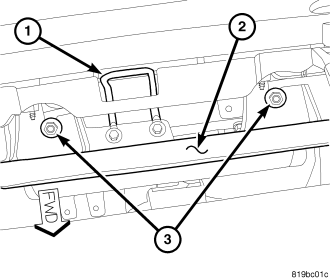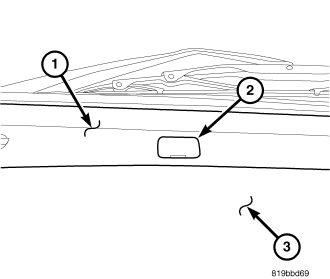INSTALLATION
WARNING:
To avoid serious or fatal injury on vehicles equipped with airbags, disable the supplemental restraint system before attempting any steering wheel, steering column, airbag,
occupant classification system, seat belt tensioner, impact sensor, or instrument panel component diagnosis or service. Disconnect and isolate the battery negative (ground) cable, then wait two minutes
for the system capacitor to discharge before performing further diagnosis or service. This is the only sure way to disable the supplemental restraint system. Failure to take the proper precautions could
result in accidental airbag deployment.
WARNING:
To avoid serious or fatal injury, use extreme care to prevent any foreign material from entering the passenger airbag, or becoming entrapped between the passenger airbag
cushion and the passenger airbag door. Failure to observe this warning could result in occupant injuries upon airbag deployment.
WARNING:
To avoid serious or fatal injury, the passenger airbag door must never be painted. Replacement passenger airbag units are serviced with doors in the original colors. Paint
may change the way in which the material of the airbag door responds to an airbag deployment. Failure to observe this warning could result in occupant injuries upon airbag deployment.
NOTE:
The following procedure is for replacement of an ineffective or damaged passenger airbag. If the airbag is ineffective or damaged, but not deployed, review the recommended
procedures for handling non-deployed supplemental restraints.
(Refer to 8 - ELECTRICAL/RESTRAINTS - STANDARD PROCEDURE - HANDLING NON-DEPLOYED
SUPPLEMENTAL RESTRAINTS). If the passenger airbag has been deployed, review the recommended procedures for service after a supplemental restraint deployment before removing the airbag from the vehicle.
(Refer to 8 - ELECTRICAL/RESTRAINTS - STANDARD PROCEDURE - SERVICE AFTER A SUPPLEMENTAL RESTRAINT DEPLOYMENT).

1.
Position the passenger airbag and airbag door to the opening in the face of the instrument panel base trim as a unit.
2.
Reconnect the two connector insulators of the instrument panel wire harness take outs to the airbag inflator connector receptacles on each side of the airbag housing by pressing straight in on
the connectors, then pushing the locks straight into the connectors. Be certain to engage each keyed and color-coded connector to the matching connector receptacle.
3.
Slide the passenger airbag forward being certain that the upper passenger airbag bracket is engaged with the stud and under the nut on the windshield fence line and that the two lower studs of
the airbag are engaged in the holes of the instrument panel armature (2).
4.
Install and tighten the two nuts (3) that secure the passenger airbag lower studs to the instrument panel armature. Tighten the nuts to 6 Nm (55 in. lbs.).
5.
Using hand pressure, press the passenger airbag door forward and downward until each snap feature on the edges of the airbag door is fully engaged into its receptacle in the instrument panel base
trim.
6.
Reinstall the grab handle onto the instrument panel.
(Refer to 23 - BODY/INSTRUMENT PANEL/GRAB HANDLE - INSTALLATION).
7.
Reinstall the glove box into the instrument panel.
(Refer to 23 - BODY/INSTRUMENT PANEL/GLOVE BOX - INSTALLATION).

8.
Working through the access hole in the top of the instrument panel (1) between the windshield and the forward edge of the passenger airbag door (3), tighten the nut that secures the passenger
airbag upper bracket and the instrument panel armature to the stud near the windshield fence line. Tighten the nut to 6 Nm (55 in. lbs.).
9.
Reinstall the trim plug (2) into the access hole in the top of the instrument panel.
10.
Do not reconnect the battery negative cable at this time. The supplemental restraint system verification test procedure should be performed following service of any supplemental restraint system
component.
(Refer to 8 - ELECTRICAL/RESTRAINTS - STANDARD PROCEDURE - VERIFICATION TEST).


